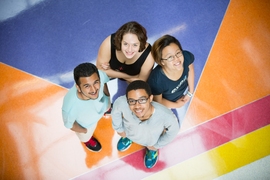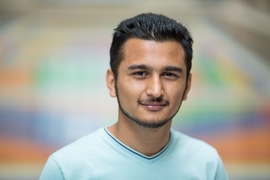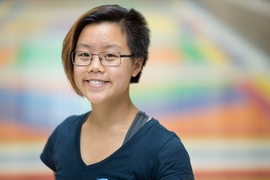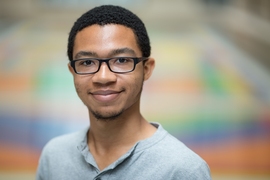With the first few weeks of classes now under their belts, first-year students are settling into the busy, challenging, and often exciting new life of the MIT student.
In these early days, MIT freshmen will no doubt be taking in new experiences at a breathless clip — an initiation that many at MIT equate with “drinking from the fire hose.”
But for first-year students like Abishkar Chhetri, the flood of education may feel more like a welcome rain after a long drought. Chhetri — one of 1,109 members of the Class of 2019 — says his admittance to MIT had a “one in a million chance of happening.”
Chhetri was born in a refugee camp in eastern Nepal, where he lived for the first seven years of his life, with little opportunity for a quality education. As he wrote in his application to MIT, “I opened my eyes to a world that promised me no future.”
The camp housed people in bamboo and straw huts, and Chhetri remembers attending the camp’s one school, where attendance was mandatory, although resources — both physical and mental — were meager.
“There were no desks or chairs — you sat on the floor,” Chhetri remembers. “There weren’t a lot of rooms, and it was really crowded, so sometimes you felt very suffocated.”
His parents, intent on giving Chhetri and his younger sister a better education, found jobs in Nepal’s capital, Katmandu, where they eventually moved the family when Chhetri was 7 years old. The improved schooling there, with more resources and qualified teachers, was “a new world for me — a place where I can be curious, and finally study without worrying about what I’m going to eat,” Chhetri says.
But after two years, the family’s dwindling finances forced them back to the refugee camp. Soon after, they learned of, and applied to, a resettlement program in the United States, which ultimately accepted them. In 2010, Chhetri and his family arrived in Atlanta with little money, and even less understanding of English.
Chhetri enrolled in an international baccalaureate school in suburban Decatur — and while he struggled with learning the language, he found he excelled at math.
“I didn’t have very good language skills, so learning social studies wasn’t very encouraging,” Chhetri recalls. “But math is a language in itself. So my ability in mathematics kept me going.”
To improve his English, he looked to YouTube, watching hours of documentaries and educational videos on a computer donated to his family. Through his online meanderings, he came across MIT’s OpenCourseWare, where he eagerly absorbed lectures on physics and math.
“I wasn’t sure I could attend a university like this, but I thought: Unrealistic things happen,” Chhetri says.
Today, as an MIT freshman, Chhetri is the first member of his family to attend a four-year college.
“Having a goal that means a lot to you, and doing everything possible to chase after it, I think that’s what makes life worthwhile, no matter if you succeed or not,” Chhetri says.
Freshmen by the numbers
Chhetri was one of a pool of 18,306 applicants to MIT, of whom just 1,519 were admitted to the Class of 2019 — an acceptance rate of 8.3 percent. Of those, 1,109 students have enrolled at the Institute, for a yield of 73 percent. The freshman class is 53 percent male and 47 percent female, and ethnically diverse: 32 percent self-identify as Asian-American; 10 percent as black or African-American; 14 percent as Hispanic or Latino; 2 percent as American Indian or Alaskan native; and 51 percent as white or Caucasian. Overall, 10 percent of the freshman class is of international citizenry, representing 69 countries.
MIT’s first-year students graduated from 835 different high schools, 65 percent of which were public; 14 percent independent; 9 percent religious; and 10 percent foreign. One percent of the incoming students were homeschooled.
Life on the ice
For incoming students, the MIT experience can be a healthy mix of competition and fun — a combination that Zoe Gong knows well. Growing up in Ottawa, Ontario, Gong dove into the world of competitive figure skating at an early age. When she was 4, her mother took her to a local rink, where she quickly took to the ice.
Soon after, Gong took up skating lessons, entering a number of local competitions. As she honed her skills, and began to qualify for and place in higher-level competitions, she found skating gradually morphed from casual fun to a serious sport.
She eventually set her sights on the Canadian National Figure Skating Championships, and aimed to qualify and compete in the novice category. The road to the finals would include several rounds of stiff competition, and Gong’s parents gave her the best chance at making it through: At 13, they moved to Colorado Springs, Colorado, where she trained 30 hours per week at the U.S. Olympic Training Site for the next three years.
Gong says that for much of her skating career, nerves had little effect on her performance. But at the start of the 2013 competition season, something felt off.
“I was having a lot of trouble with jumps, and would get really scared and anxious and nervous, and couldn’t make myself commit, and I would fall a lot,” Gong says. “It really got to me mentally.”
She decided to call it quits, and stopped training for several months. What got her back on the ice was the support of friends — fellow competitors in the skating community. With their backing, Gong started training again, slowly working her way up through the rankings, and eventually, to the finals. All her hard work paid off, as Gong won gold, taking up the 2013 national champion title.
“That year definitely taught me how to fall down a lot, very painfully, and get back up every time and go around again and do the exact same thing,” Gong says.
She credits part of her success to her skating “family” — coaches and fellow competitors, who taught her more than the sport itself. Through this community, Gong became active in raising awareness of LGBTQ issues, and organized fundraisers at her high school to support charities and foundations.
“The figure-skating community is really open, and I was lucky to have grown up around really accepting and welcoming and queer-friendly people,” Gong says. “I think it’s really important to help people who are less fortunate, and grew up in less accepting and tolerant communities.”
At MIT, Gong hopes to “give a little back to the sport” by perhaps coaching through the Figure Skating Club. As for what to study, she’s considering computer science or mechanical engineering, although she’s eager to explore her options.
“I want to keep an open mind and try as many things as possible to find something I’m really passionate about, and that I’d like to work on forever,” Gong says.
The universal language
For Michael Hartman, attending MIT — or any school, for that matter — is an entirely new experience. Hartman, who hails from Greenville, South Carolina, was homeschooled for his entire education by his mother, a registered nurse with a bachelor’s degree in computer science. His father was a manager at the chemical company BASF, a job that would move the family several times within Louisiana and South Carolina. Homeschooling, then, was a dependable constant for Hartman and his brother. It also gave them flexibility and spontaneity in choosing what to study.
Hartman recalls one particular school day, when he was about 5 years old. His mother was driving the brothers home from an outing when she declared that the boys would learn to play instruments, and pulled the car into a local music store. Inside, the owner brought out a viola and started to play.
“I was just captivated by how good it sounded, and I was going to say, ‘I want to play the viola’ — but I talk very slow, so my brother got it out before I did,” Hartman says. “I didn’t want to make it look like I was just copying him, so I said, ‘I’ll take the big one.’”
Hartman now describes playing cello as a way to “tell stories that have no words … told in the universal language of music.” He has gone on to win numerous awards in solo and orchestral performance; last January, he performed as a soloist with the Young Artist Orchestra in Greenville.
In high school, Hartman and his brother founded the Brothers Hartman String Duet, and performed at various functions around town, even appearing on a local television program showcasing young talent. The group’s highest-profile gig came about by happenstance.
“My dad was on a plane going somewhere for a business trip, and he said to the person sitting beside him, ‘You look exactly like Wynton Marsalis,’” Hartman says.
The man turned out to be Marsalis’ brother, Delfeayo, a noted jazz trombonist. Hartman’s father told Marsalis about his sons, who in turn asked for a recording. In 2010, the brothers were invited to play at a jazz festival with Marsalis and the New Orleans Philharmonic.
At MIT, Hartman hopes to join the MIT Symphony Orchestra, and to continue to take private lessons. But he’s most excited about the hands-on prospects of mechanical engineering, which he got a taste of through his senior project — disassembling and then reassembling the engine of the family’s lawnmower.
Hartman has also long held a fascination with high-performance cars, and has ambitious goals of producing a line of his own some day.
“I want to be an engineer because I like to build stuff,” Hartman says. “But I also figured out what I really wanted to do is make my own car brand, like Ferrari, Lamborghini, Hartman. It seems impossible, but there are people who do it, and if it’s not impossible, that’s good enough for me.”
Standing for STEM
A similar determination has driven Riana Hoagland. Raised in Olympia, Washington, by her mother, a math teacher, and her father, a computer science teacher, Hoagland grew up with an ingrained curiosity for all things related to science and technology. In school, she excelled at math and science, and developed an early interest in computer science.
It wasn’t until 11th grade that Hoagland looked around her physics class and noticed only a handful of other girls in the room. The same went for her calculus class.
“I never had a problem being interested in these subjects, but some of my best friends weren’t as good, and always felt they weren’t really supposed to be an engineer — that’s a guy thing,” Hoagland says.
She herself felt the stereotype when looking for clubs to join. “The computer science, math, and robotics clubs were just all guys, and it was a little intimidating,” Hoagland says.
To reverse the stereotype, she and 30 other girls at the school, along with their math teacher, started the dotDiva Club, taking a page from the national organization by the same name, which works to support women in science, technology, engineering, and mathematics (STEM) fields. Hoagland served as president of the club for its first two years, during which the club offered computer programming lessons using Java, Lego Mindstorm robots, and RobotC programming. Hoagland also organized a schoolwide “Hour of Code,” part of a worldwide effort to teach students computer programming through hourlong tutorials.
Hoagland doesn’t plan to become a computer scientist, although she says familiarity with computers is becoming an essential skill in many fields.
“Computer science is now super-important,” Hoagland says. “I’m going to go into biological engineering, and you need computer skills to code all your data. Even if you’re not going to be a computer scientist, you still need to know what you’re doing.”
Hoagland already has quite a bit of experience in both computer science and biology. For the last two years, she’s volunteered in several biology and neuroengineering labs, most recently working as an assistant with a research group in Olympia where scientists are investigating the neurological basis for behaviors during early development. Hoagland has helped analyze videos of premature babies, taking down instances when infants touch themselves, and matching the data up with pre-recorded heart-rate responses. The scientists hope the data will elucidate ways in which babies first develop self-awareness.
At MIT, Hoagland plans to study bioengineering, with the ultimate goal of earning a PhD and eventually running her own lab to develop medical innovations. She also wants to inspire other girls to do the same, and hopes to participate in campus outreach programs to recruit elementary and middle school girls to STEM fields.
“It’s important to get them into it at an early age to make sure they don’t get a bad representation of STEM in their minds,” Hoagland says. “I’d really like there to be more girls. I don’t want there to be any stereotypes of me like, ‘She’s a girl.’ Yeah, so?”



















